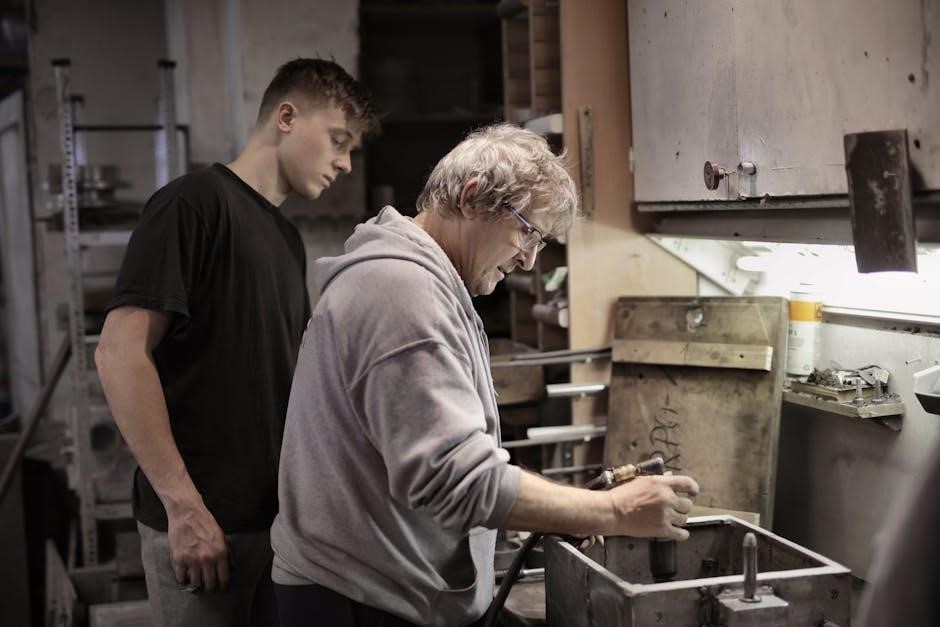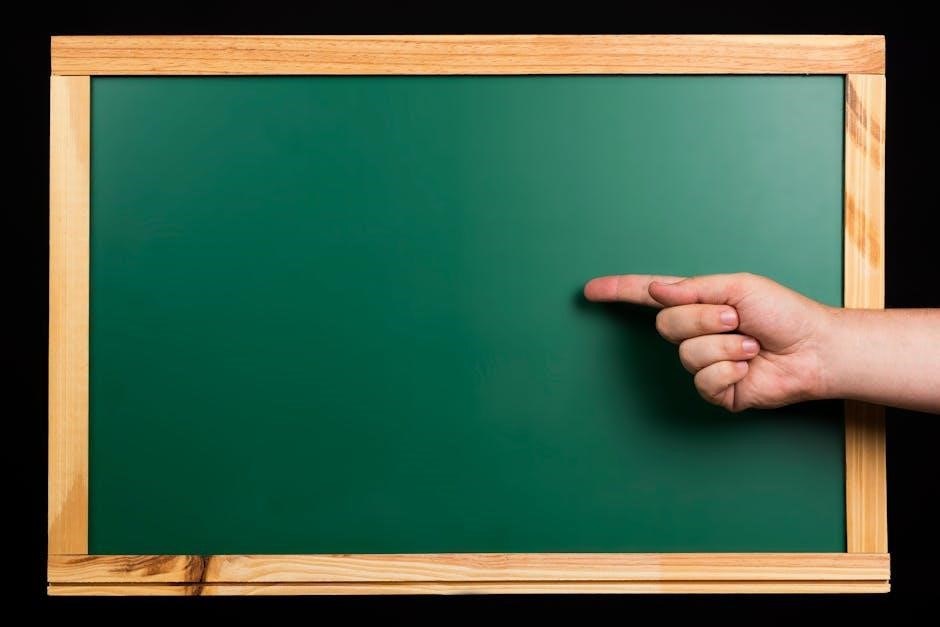Welcome to your pressure cooker instruction manual! This guide provides essential information for safe and effective use of your appliance․ Inside‚ you’ll find detailed instructions on components‚ safety precautions‚ operating steps‚ and troubleshooting tips to ensure optimal performance and delicious meals․ Designed to enhance your cooking experience‚ this manual covers everything from basic setup to advanced techniques․ Read carefully to unlock the full potential of your pressure cooker and enjoy cooking with confidence and ease․
1․1 Importance of Reading the Manual
Reading the pressure cooker instruction manual is essential for safe and effective use; It provides crucial information about components‚ safety guidelines‚ and operating procedures․ Understanding the manual ensures you can assemble‚ use‚ and maintain your cooker properly․ It also helps prevent accidents by highlighting potential hazards‚ such as steam burns and improper lid sealing․ The manual offers troubleshooting tips and cooking recommendations‚ making it a valuable resource for both beginners and experienced users․ Always refer to it before first use to maximize efficiency and avoid risks․
1․2 Overview of Pressure Cooker Components
Your pressure cooker consists of essential components designed for safe and efficient cooking․ The inner pot holds the food and liquid‚ while the lid seals the cooker‚ equipped with a handle for easy opening and closing․ The pressure regulator or valve controls the pressure level‚ ensuring safe operation․ A gasket or sealing ring ensures a tight seal to prevent steam leakage․ Additional features may include a steam basket or trivet․ Understanding these components is vital for proper usage and maintenance‚ as outlined in the manual carefully․

Safety Precautions
Always read the manual before use․ Keep hands and face away from steam to avoid burns․ Ensure the cooker is on a stable surface and never leave it unattended while in operation․ Regularly inspect the gasket and pressure valve for damage․ Supervise children when the cooker is in use․ Follow all safety guidelines to prevent accidents and ensure safe‚ efficient cooking every time․
2․1 Basic Safety Guidelines
Always read the manual thoroughly before using your pressure cooker․ Ensure the appliance is placed on a stable‚ heat-resistant surface․ Never leave the cooker unattended while it is in operation․ Keep children away from the cooker‚ as the steam and hot surfaces can cause burns․ Regularly inspect the gasket and pressure valve for any signs of wear or damage․ Avoid touching the cooker’s hot surfaces; use the handles provided․ Proper maintenance and adherence to these guidelines will ensure safe and efficient cooking․ Stay alert and cautious during the cooking process to prevent accidents․
2․2 Avoiding Steam Burns
Steam from a pressure cooker can cause severe burns‚ so handle it with caution․ Always open the lid away from your face and body․ Use oven mitts or a towel to protect your hands when handling hot components․ Never tilt the cooker to pour contents‚ as this can direct steam toward you․ Keep children away during operation and pressure release․ Properly vent the cooker before opening to avoid sudden steam bursts․ These precautions will help prevent accidents and ensure a safe cooking experience with your pressure cooker․
2․3 Supervision and Usage Near Children
Always keep children away from the pressure cooker while it is in use․ The appliance produces hot steam and has high-pressure components that can cause injury․ Supervise children closely to ensure they do not touch or interfere with the cooker․ Teach them about the dangers of hot surfaces and steam․ Never allow children to operate the pressure cooker unsupervised․ Maintain a safe distance to prevent accidental burns or injuries․ This precaution ensures a safe cooking environment for everyone in the household․

Understanding Your Pressure Cooker
Understanding your pressure cooker is key to safe and effective cooking․ Familiarize yourself with its components‚ settings‚ and operations to maximize its potential and ensure proper functionality․ Learn how to use the pressure regulator‚ sealing ring‚ and other essential parts for optimal performance․ This knowledge will help you achieve consistent results and maintain your appliance for years of reliable service․
3․1 Components of a Pressure Cooker
A pressure cooker consists of several key components․ The inner pot holds the food and liquid‚ while the lid seals the cooker to build pressure․ The pressure regulator controls the pressure level‚ and the sealing ring ensures a tight‚ airtight seal․ Additional parts include the handle for safe lifting‚ the valve for pressure release‚ and the locking mechanism to secure the lid․ Understanding each part’s function is essential for safe and effective cooking․ These components work together to create a controlled cooking environment for faster and more efficient meal preparation․
3․2 Types of Pressure Cookers (Stovetop‚ Electric‚ Microwave)
Pressure cookers come in three main types: stovetop‚ electric‚ and microwave․ Stovetop models are traditional‚ offering precise control over heat and pressure․ Electric pressure cookers are modern‚ with programmable settings and ease of use․ Microwave pressure cookers combine pressure cooking with microwave functionality for faster results․ Each type has unique features‚ catering to different cooking preferences and needs․ Understanding the differences helps users choose the right model for their lifestyle‚ ensuring efficient and safe cooking experiences․

Assembly and Initial Setup
Begin by carefully unpacking and inspecting all components․ Wash the pot‚ lid‚ and sealing ring before first use․ Follow the manual to assemble and attach parts like the lid and sealing ring properly․ Ensure all connections are secure for safe operation․ Proper setup is crucial for optimal performance and safety․ Refer to the manual for detailed instructions to avoid mistakes during assembly and initial preparation․
4․1 Unpacking and Cleaning Before First Use
Start by carefully unpacking your pressure cooker and inspecting for any damage․ Wash the inner pot‚ lid‚ and sealing ring with mild soap and warm water․ Rinse thoroughly and dry with a clean towel․ Remove any protective packaging from components like the pressure regulator or valve․ Ensure all parts are free from factory residue or dust․ Cleaning before first use prevents contamination and ensures optimal performance․ Proper preparation guarantees a safe and effective cooking experience with your new appliance․
4․2 Attaching the Lid and Sealing Ring
To ensure proper function‚ align the lid with the cooker base and gently lower it into place․ Secure the lid by turning it clockwise until it clicks․ The sealing ring must be correctly positioned in the lid’s groove to create an airtight seal․ Inspect the ring for damage or wear before installation․ Once attached‚ check the alignment by rotating the lid slightly․ A secure fit is crucial for safe operation and effective pressure building․ Always verify the lid and sealing ring are properly installed before cooking to avoid steam leakage and ensure optimal performance․

Operating the Pressure Cooker
Operating your pressure cooker is straightforward once familiar with its controls․ Start by adding ingredients‚ then set the timer or manual mode․ Secure the lid‚ ensure the valve is closed‚ and select your pressure setting․ The cooker will build pressure and begin the cooking cycle․ Always follow recipes for timing and pressure levels․ Once done‚ allow natural pressure release or use the quick-release method․ Refer to the manual for specific settings and guidelines to achieve perfect results every time․ Proper operation ensures safety and delicious meals․
5․1 Basic Cooking Steps
Start by ensuring the pressure cooker is preheated and clean․ Add the recommended amount of liquid to the inner pot․ Place your ingredients inside‚ ensuring not to overfill․ Secure the lid tightly‚ aligning the valve for sealing․ Select the desired pressure setting and set the cooking time․ Allow the cooker to build pressure naturally․ Once the cycle completes‚ release pressure either by natural release or quick release․ Open the lid away from your face to avoid steam burns․ Always follow recipe guidelines for precise cooking times and liquid ratios to achieve optimal results․ Proper steps ensure safe and efficient cooking․
5․2 Manual Setting for Custom Cooking
For precise control‚ use the manual setting to adjust cooking time and pressure according to your recipe․ This feature allows you to tailor settings for specific ingredients‚ ensuring optimal results; High pressure is ideal for tougher meats and legumes‚ while low pressure suits delicate foods like fish or vegetables․ Always refer to the manual for guidelines on liquid ratios and filling limits to avoid overflow․ Custom settings enhance versatility‚ enabling you to achieve perfect doneness for a wide variety of dishes․ Experiment with different pressures and times to refine your cooking technique․
5․3 Natural vs․ Quick Pressure Release
Understanding pressure release methods is crucial for safe and effective cooking․ Natural release allows the pressure to drop gradually on its own‚ ideal for foods like grains and legumes․ Quick release involves manually opening the valve to release steam rapidly‚ suitable for vegetables and meats․ Always keep hands and face away during release to avoid burns․ Natural release prevents overcooking‚ while quick release stops the cooking process immediately․ Use the method recommended in your recipe for best results․ Consult the manual for specific guidance on release times and techniques․

Cooking Times and Methods
Cooking times vary based on food type and pressure levels․ Adjust settings for meats‚ grains‚ and vegetables to achieve perfect doneness․ Use natural or quick release methods as needed․
6․1 Recommended Cooking Times for Common Foods
Cooking times in a pressure cooker vary based on the type of food․ Grains like rice and quinoa typically cook in 4-8 minutes‚ while beans require 20-30 minutes․ Meats such as chicken or beef take 15-25 minutes for tender results․ Vegetables like carrots or potatoes cook quickly‚ needing only 5-10 minutes․ Adjust times based on quantity and desired texture․ Always refer to the manual for specific guidelines‚ as overcooking can occur․ Use natural or quick release methods as appropriate for the recipe․ Proper timing ensures perfectly cooked meals every time․
6․2 Adjusting Pressure for Different Recipes
Pressure adjustment is crucial for achieving desired results in various recipes․ Delicate foods like fish or eggs require lower pressure‚ while tougher meats or legumes need higher settings․ Use the pressure regulator to customize settings‚ ensuring optimal cooking․ For example‚ set to high pressure for quick cooking of dense foods or low pressure for gentle simmering․ Refer to the manual for specific guidelines on adjusting pressure for different ingredients․ Proper pressure control enhances texture and flavor‚ making every dish perfectly cooked․ Experiment with settings to master a wide range of recipes effortlessly․

Care and Maintenance
Regularly clean and dry your pressure cooker to maintain performance․ Avoid abrasive cleaners and ensure all parts are free from food residue․ Store securely to prevent damage and always inspect components before use for optimal safety and efficiency․
7․1 Cleaning the Pressure Cooker
After each use‚ wash the pressure cooker’s components with mild soap and warm water․ Avoid using abrasive cleaners or scourers to prevent damage․ Dry all parts thoroughly to prevent rust․ Regularly inspect and clean the lid‚ gasket‚ and pressure regulator to ensure proper sealing and function․ For tough stains‚ soak components before cleaning․ Always refer to the manual for specific cleaning instructions for your model to maintain performance and longevity․
7․2 Storing the Pressure Cooker
After cleaning‚ store the pressure cooker in a dry place to prevent rust․ Ensure all components‚ including the lid and gasket‚ are completely dry․ Do not store food in the cooker․ Keep the lid separate from the pot to allow moisture to evaporate․ Avoid stacking heavy objects on the cooker to maintain its shape and functionality․ Regularly inspect stored parts for signs of wear or damage․ Proper storage ensures your pressure cooker remains in optimal condition for future use․

Troubleshooting Common Issues
This section guides you through diagnosing and resolving common pressure cooker problems‚ such as malfunctioning pressure regulators or improper sealing‚ ensuring safe and effective appliance operation․
8․1 Pressure Regulator Malfunction
A malfunctioning pressure regulator can cause improper pressure control‚ leading to unsafe conditions․ If the regulator is clogged or damaged‚ the cooker may whistle excessively or fail to maintain pressure․ To address this‚ inspect the regulator for blockages and clean or replace it as needed․ Ensure all parts are securely attached․ If issues persist‚ consult a professional or refer to the manufacturer’s guidelines for replacement․ Always keep hands and face away from steam to prevent burns during troubleshooting․ Regular maintenance can help prevent such malfunctions and ensure safe‚ efficient cooking․
8․2 Lid Not Sealing Properly
If the lid of your pressure cooker isn’t sealing correctly‚ it can prevent proper pressure buildup and lead to safety hazards․ Check for food residue or debris on the sealing ring and lid‚ as these can block the seal․ Clean thoroughly with warm water and mild detergent․ Inspect the gasket for wear or damage; replace it if necessary․ Ensure the lid is aligned correctly and twisted into position firmly․ If issues persist‚ refer to the manufacturer’s troubleshooting guide or replace the sealing ring․ Regular maintenance helps maintain a secure seal and ensures safe operation․ Always prioritize lid functionality for optimal performance․

Advanced Cooking Techniques
Explore advanced cooking techniques to elevate your culinary skills․ Learn methods for layering ingredients‚ enhancing flavors‚ and customizing settings for perfect results every time with your pressure cooker․
9․1 Cooking Grains and Legumes
Cooking grains and legumes in a pressure cooker is efficient and nutritious․ Use a 2:1 water-to-grain ratio for rice‚ quinoa‚ or oats‚ and adjust for beans based on size․ Add seasonings for flavor․ Cook on high pressure for 6-8 minutes‚ then allow natural release․ For legumes like lentils or chickpeas‚ pre-soaking reduces cooking time․ Always rinse grains before cooking to remove impurities․ This method ensures tender‚ evenly cooked results while retaining nutrients for a healthy meal․ Experiment with herbs and spices for added taste․ Always follow manual guidelines for specific timings and ratios․
9․2 Cooking Meats to Perfection
Pressure cookers excel at cooking meats to tender perfection quickly․ For tougher cuts like brisket or pot roast‚ use a marinade and cook on high pressure for 30-40 minutes․ Add enough liquid to cover the meat halfway‚ ensuring even cooking․ Always seal the lid properly to maintain pressure․ For poultry‚ cook on high for 15-25 minutes‚ depending on size․ Use natural pressure release for 10 minutes before quick-releasing․ Brown meats pre- or post-cooking for enhanced texture and flavor․ This method ensures juicy‚ flavorful results every time‚ making it ideal for hearty meals․ Always follow safety guidelines for handling hot meat․

Accessing the Instruction Manual
Access your pressure cooker manual by downloading the free PDF version or ordering a printed copy through the official website or manufacturer’s portal for easy reference and safe operation․
10․1 Downloading the PDF Version
To download the PDF version of your pressure cooker instruction manual‚ visit the official manufacturer’s website or the product page․ Locate the “Downloads” or “Support” section‚ where you’ll find a direct link to the manual․ Click on the link to begin the download․ Ensure your device has sufficient storage and a compatible PDF reader installed․ Once downloaded‚ save the file in an easily accessible location for future reference․ This digital version allows convenient access and can be printed if needed‚ ensuring you always have the guide handy for troubleshooting or cooking instructions․
10․2 Ordering a Printed Copy
To order a printed copy of the pressure cooker instruction manual‚ visit the manufacturer’s official website․ Navigate to the “Support” or “Resources” section‚ where you’ll often find an option to purchase a physical copy․ Click on the “Add to Cart” button and follow the checkout process․ Ensure your shipping details are accurate to receive the manual promptly․ Some manufacturers may also offer this service through their customer support team․ A printed manual is ideal for those who prefer a physical guide for easy reference while cooking or troubleshooting․
Congratulations on completing the pressure cooker instruction manual! This guide has provided you with essential information to safely and effectively use your appliance․ From understanding components to advanced cooking techniques‚ you’re now equipped to unlock the full potential of your pressure cooker․ Remember to always follow safety guidelines and explore the versatility of pressure cooking for delicious‚ quick‚ and healthy meals․ Happy cooking‚ and enjoy the culinary adventures ahead with your reliable kitchen companion!

